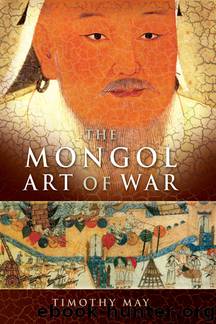Mongol Art of War by Timothy May

Author:Timothy May
Language: eng
Format: epub
Tags: Bisac Code 1: HIS003000
ISBN: eBook ISBN: 9781844683673
Publisher: Pen and Sword
Published: 2007-03-21T16:00:00+00:00
The Hungarians
The Mongols carried out their invasion of Europe in 1241 on a wide front, striking both Hungary and Poland. Poland, however, was a secondary target, while the main force drove into Hungary. This was for a number of reasons. The fact that over 40,000 Kipchak Turks fled to Hungary from the Mongols played an important part in the decision. In addition, the Hungarians possessed a very strong army and in recent years had slowly begun extending their influence into the Kipchak Steppe, thus posing a potential threat to the Mongols.
Organization
Like virtually all European armies, the Hungarian army was raised by means of the feudal system. Benefiting from the Alföld Plain – that part of the Eurasian Steppe that extends into Hungary – they possessed an exceptionally large cavalry. Their elite troops were mail armored knights, who relied on a massive and virtually unstoppable charge as their primary offensive maneuver; but due to their country’s proximity to the steppe the Hungarians also possessed a number of nomadic or nomadic-influenced light cavalry, who served as scouts and skirmishers.
In addition the nobility and the king fielded retinues of sergeants who fought on horseback and on foot. Those on horseback were, typically, professional soldiers who could not become knights due to their low-born origins. Those who served as infantry were shock troops and provided a stable core for the rest of the infantry, who varied in ability and at times consisted of conscripted peasants using a variety of weapons, typically farming implements or spears.
Despite the preponderance of horsemen in Hungarian armies, they still traveled relatively slowly. This was partially because they were accompanied by infantry but was also due to the army’s wagons, which as well as carrying supplies were also integral to the army’s defense. At night, the troops chained the wagons together to form a laager to protect the army – a wise precaution for a country bordering the steppe.
In feudal states, the control of a king over his vassals varied greatly, and it was in an attempt to strengthen his own position that Bela IV – the ruler of Hungary at the time of the Mongol invasions – decided to strengthen his hand militarily by agreeing to allow a large number of Kipchaks to settle within the kingdom. The Kipchak Khan, Koten, fleeing from the Mongols, accepted the pre-condition of baptism and entered Bela’s service. The addition of a large number of Kipchak warriors strengthened Bela’s position not only against the Mongols, but also against his own recalcitrant vassals. Unfortunately the vassals, who already opposed Bela’s attempts to increase royal prerogatives, resented the Kipchak presence.7 Furthermore, the pastoral nomadic lifestyle of the Kipchaks did not mesh well with the sedentary lives of Hungary’s peasants and nobles. Clashes became inevitable and the nobility lynched Koten. The Kipchaks reacted by rampaging through Hungary until they entered Bulgaria and even the Byzantine Empire, where many found refuge. Thus the Hungarians lost a valuable contingent of veteran nomadic warriors on the very eve of the Mongol invasion.
Download
This site does not store any files on its server. We only index and link to content provided by other sites. Please contact the content providers to delete copyright contents if any and email us, we'll remove relevant links or contents immediately.
The Radium Girls by Kate Moore(10923)
The Templars by Dan Jones(4197)
100 Deadly Skills by Clint Emerson(4090)
Rise and Kill First by Ronen Bergman(4026)
The Doomsday Machine by Daniel Ellsberg(3742)
The Rape of Nanking by Iris Chang(3530)
Killing England by Bill O'Reilly(3466)
Hitler in Los Angeles by Steven J. Ross(3450)
Stalin by Stephen Kotkin(3094)
12 Strong by Doug Stanton(3064)
Hitler's Monsters by Eric Kurlander(2740)
Darkest Hour by Anthony McCarten(2655)
Blood and Sand by Alex Von Tunzelmann(2615)
The Art of War Visualized by Jessica Hagy(2424)
Hitler's Flying Saucers: A Guide to German Flying Discs of the Second World War by Stevens Henry(2305)
The Code Book by Simon Singh(2222)
The Second World Wars by Victor Davis Hanson(2140)
Babylon's Ark by Lawrence Anthony(2077)
Tobruk by Peter Fitzsimons(2068)
